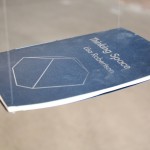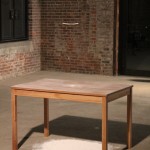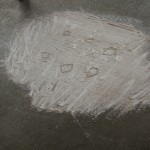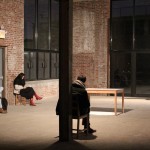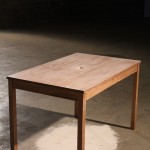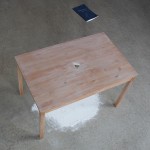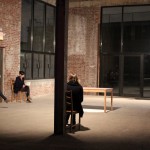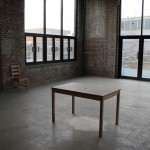- No products in the cart.
Model of an Error was installed during the Initial Contractions exhibition on Saturday, November 23, 2013 at the Knockdown Center in Queens, New York.
Starting out from the text of Lisa Robertson’s essay “Thinking Space,” which was published a week prior by the OPR, we attempted to reconstruct an optics experiment described in the essay, which was first performed by Johannes Kepler in 1601. Robertson calls Kepler’s experiment a “geometrical model of the optical refraction effect,” and because the experiment was designed to account for distortions in data pertaining to planetary motion (due to the refraction of light passing through a lens or aperture), Robertson also calls the experiment “a model of an error.”
Kepler’s description of his experiment, which Robertson quotes at length, caught our attention for a few reasons: First, because the passage foregrounds and, somewhat ironically, recapitulates a problem of description and interpretation that Kepler himself encounters vis-à-vis an earlier astronomer, John Peckam (or Pisanus), from whom Kepler had adapted this optics experiment. As Kepler writes:
A certain light drove me from the shadows of Pisanus several years ago. For indeed, since I could not comprehend the obscure sense of [his] words from the diagram on the page, I had recourse to a personal observation in three dimensions. I placed a book on high to take the place of the shining body. Between it and the floor I set a table having a many-cornered aperture. Next, a thread was sent down from one corner of the book through the aperture and onto the floor; it fell on the floor in such a way that it grazed the edges of the aperture; I traced the path produced and by this method created a figure on the floor similar to the aperture. Likewise, by means of a thread attached to another, a third, a fourth corner of the book, and finally to an indefinite number of [points] along the edge, there resulted on the ground an indefinite number of traced figures [each having the shape] of the aperture, which together produced a great and four cornered [figure having the] shape of the book.
In spite of his critique of “the obscure sense of [Pisanus’s] words,” Kepler’s description was not itself immediately clear, and the urge to pursue our own “personal observation in three dimensions” became manifest.
A second reason the passage commanded our attention was that Kepler’s experimental object, once adequately envisioned, appeared emblematic of the essay itself. We realized that if we were to reconstruct this object, it would become a three-dimensional model of the essay’s major themes and concerns. Once installed at the KDC, the model seemed to concretize a scene described in the opening of the essay: “There is a series of rooms. Each room frames a table, a book, and an opening to the outside–an aperture of some sort. At times they may be called studies or observatories or libraries but they are only rooms. Each has shaped a research.”
Following Kepler’s model, we suspended a copy of “Thinking Space” above a table. In the center of the table we cut a “many-cornered aperture” in the shape of the foremost face of Dürer’s solid (from Melancholia I, referenced in the essay), an image which we had adapted for the book’s cover. We traced the shape of the aperture into a thin pile of pulverized chalk that lay under the table with a dowel rod, attached by mono-filament at six points along the edges of the book: at each of the corners and at the mid-points of the two longer sides. As Robertson writes, “The room is an eye. The table is a retina. The book is a sun.” Around the table, in places of repose and relative isolation, we placed four chairs, each with a reading copy of “Thinking Space,” inviting visitors to read and to look–to contemplate the essay and the experiment through different media, thereby varying and complicating the experience of both text and object.

